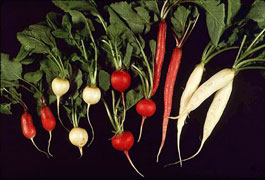


Home
Flowers &
Indoor Plants
Fruits & Nuts
Ornamentals
Vegetables
Special Topics
Resources
Glossary

Radish |
 |
What about it? Radishes are in the mustard family along with kale, mustard and turnips. They are one of the easiest crops to grow and typically one of the first in a child's garden. There are many different varieties, including small red ones and big white storage types. The Japanese daikon radish is 18 inches long. What is it used for? Radishes are grown for their long and tangy tap root. Radishes are also grown to loosen up the soil. Where does it grow? How do we grow it? Radishes have the mildest flavor and the best texture when grown in cool temperatures. Radishes are quick to mature, taking between 3 and 6 weeks. There is a variety that matures in 18 days. (...So, if you want quick results in your garden to impress your friends...) Radishes will need to be thinned. Too much heat and not enough watering will give you pithy, very hot radishes. Some gardeners even plant radishes right in the carrot rows. They ripen much quicker than the carrots do and loosen up the soil for their companions. Radishes prefer a well-drained, well-tilled soil. What are its primary problems? The cabbage root maggot is the biggest problem. This can be avoided by putting hardwood ashes in the soil before planting or plant at weekly intervals so some avoid attack Surprisingly, some gardeners will plant radishes along with cabbages as a foil for the maggot. Seeds can be treated for damping-off and root rots. As always, if you use treated seed, use gloves. How do we propagate it? Sow radishes directly in the garden, planting them 1 inch apart and 12 inch deep. For larger radishes, give them more growing room. How do we harvest and store it? Radishes can be harvested a month after seeding. Pick the radish at the size you prefer. Don't wait until they have become tough and pithy though. Store them in plastic bags in the refrigerator.
© Copyright, Department of Horticulture, Cornell University. |